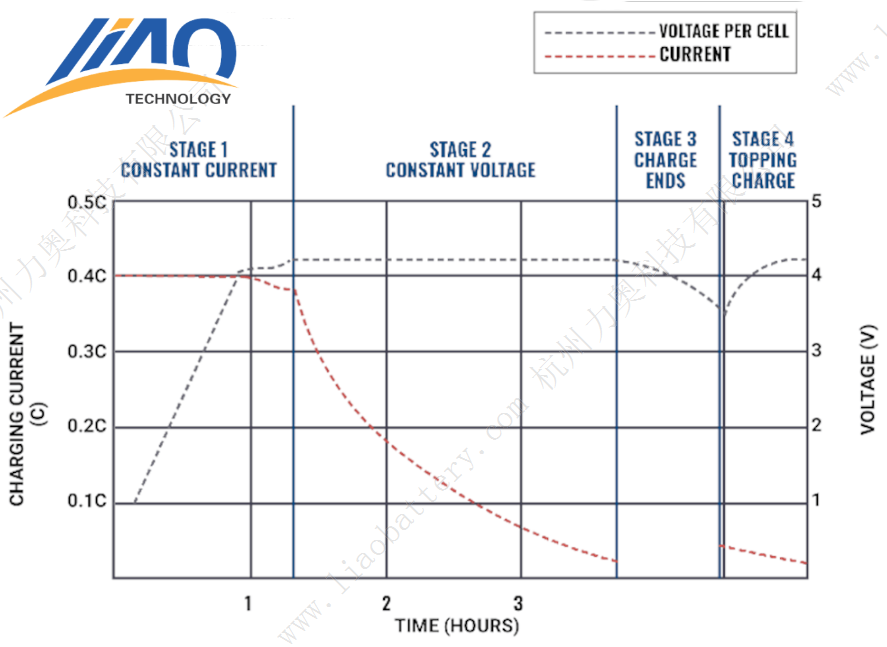If you’ve recently purchased or are researching lithium iron phosphate batteries (referred to lithium orLiFeP04 in this blog), you know they provide more cycles, an even distribution of power delivery, andweigh less than a comparable sealed lead acid (SLA) battery. Did you know they can also charge fourtimes faster than SLA? But exactly how do you charge a lithium battery, anyway?
LIFEPO4 BATTERY CHARGING PROFILE
A LiFeP04 battery uses the same constant current and constant voltage stages as the SLA battery.Even though these two stages are similar and perform the same function, the advantage of the LiFeP04battery is that the rate of charge can be much higher, making the charge time much faster.

Stage 1 battery charging is typically done at 30%-100% (0.3C to 1.0c) current of the capacity rating ofthe battery. Stage 1 of the SLA chart above takes four hours to complete. The Stage 1 of a lithiumbattery can take as little as one hour to complete, making a lithium battery available for use four timesfaster than SLA. Shown in the chart above, the Lithium battery is charged at only 0.5C and still chargesalmost 3 times as fast! As shown in the chart above, the Lithium battery is charged at only 0.5C andstill charges almost 3 times as fast!
Stage 2 is necessary in both chemistries to bring the battery to 100% $oc. The SLA battery takes 6hours to complete Stage 2, whereas the lithium battery can take as little as 15 minutes. Overall, thelithium battery charges in four hours, and the SLA battery typically takes 10. in cyclic applications, thecharge time is very critical. A lithium battery can be charged and discharged several times a day,whereas a lead acid battery can only be fully cycled once a day.
Where they become different in charging profiles is Stage 3 A lithium battery does not need a floatcharge like lead acid. in long-term storage applications, a lithium battery should not be stored at 100%S0c, and therefore can be maintained with a full cycle (charged and discharged) once every 6 – 12months and then storage charged to only 50% SoC.
In standby applications, since the self-discharge rate of lithium is so low, the lithium battery will deliverclose to full capacity even if it has not been charged for 6 – 12 months. For longer periods of time, acharge system that provides a topping charge based on voltage is recommended. This is especiallyimportant with our Bluetooth batteries where the Bluetooth module draws a very small current from thebattery even when not in use.
Long term storage
If you need to keep your batteries in storage for an extended period, there are a few things to consideras the storage requirements are different for SLA and lithium batteries. There are two main reasonsthat storing an SLA versus a Lithium battery is different.
The first reason is that the chemistry of the battery determines the optimal soc for storage. For an SLAbattery, you want to store it as close to possible as 100% $OC to avoid sulfating, which causes abuildup of sulfate crystals on the plates. The buildup of sulfate crystals will diminish the capacity of thebattery.
For a lithium battery the structure of the positive terminal becomes unstable when depleted ofelectrons for long periods of time. The instability of the positive terminal can lead to permanentcapacity loss, For this reason, a lithium battery should be stored near 50% Soc, which equallydistributes the electrons on the positive and negative terminals. For detailed recommendations on longterm Lithium storage, check out this guide regarding storage of Lithium batteries
The second influence on storage is the self-discharge rate. The high self-discharge rate of the SLAbattery means that you should put it on a float charge or a trickle charge to maintain it as close aspossible to 100% Soc to avoid permanent capacity loss. For a lithium battery, which has a much lowerdischarge rate and doesn’t need to be at 100% $OC, you may be able to get away with minimalmaintenance charging.
Recommended battery chargers
it is always important to match your charger to deliver the correct current and voltage for the battery you are charging. For example, you wouldn’t use a 24V charger to charge a 12v battery. lt is alsorecommended that you use a charger matched to your battery chemistry, barring the notes from aboveon how to use an SLA charger with a lithium battery. Additionally, when charging a lithium battery with anormal SLA charger, you would want to ensure that the charger does not have a desulfation mode or adead battery mode.
If you have any questions about an existing charger’s capability with one of our products, please give usa call or send us an email. We would be happy to assist you with your charging needs.
Post time: Feb-27-2024
